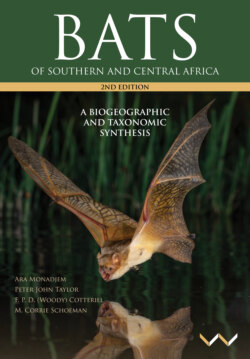Читать книгу Bats of Southern and Central Africa - Ara Monadjem - Страница 55
На сайте Литреса книга снята с продажи.
ОглавлениеEpomophorus angolensis Gray 1870
Angolan epauletted fruit bat Near Threatened
Description: Epomophorus angolensis is a large bat with a mass of around 90 g. Its external appearance is very similar to E. crypturus. The pelage is light sandy-brown. The underparts are paler than the upper parts. The wings are light brown and sparsely covered in hair. Adult males are much larger than females, and may be distinguished by a broader muzzle with a folded upper lip and the presence of shoulder epaulettes. These epaulettes are pockets containing long, white fur that can be erected to display prominent white shoulder patches. At rest, these patches disappear as the fur is retracted into the pocket. The ears have a patch of white fur at their base. The muzzle is dog-like and similar to that of E. crypturus.
The skull is relatively robust with sturdy zygomatic arches. In lateral profile, the entire cranium is dorsoventrally flattened and only very slightly bowed; the rostrum gradually slopes downwards anteriorly and the braincase is very slightly deflected downward posteriorly. The sagittal crest is weak, while the lambdoid crest is fairly well developed. There are six narrow palatal ridges present, two beyond the last molar. The fourth palatal ridge is nearer the third than the fifth ridge. The dental formula is 2121/2132 = 28.
| External and cranial measurements (mm) and mass (g) for Epomophorus angolensis, sexes combined | |||||
|---|---|---|---|---|---|
| Mean | Min | Max | SD | N | |
| Mass 1 | 86 | 80 | 92 | - | 2 |
| FA 1 | 81.7 | 76 | 90 | - | 3 |
| Total 1 | 147.3 | 140 | 154 | 5.89 | 6 |
| Tail | - | - | - | - | - |
| Tibia | - | - | - | - | - |
| Ear 1 | 24.5 | 24 | 26 | 0.89 | 6 |
| CI 1 | 50.7 | 45.4 | 59.6 | 5.24 | 9 |
1 Specimens measured by the authors
Key identification features: The combination of white patches at the base of the ears and shoulder epaulettes (males) separates Epomophorus and Epomops from other fruit bats. Palatal ridges of Epomops are very different from those of Epomophorus; in the latter there are six narrow ridges. Adult E. angolensis can be distinguished from sympatric E. wahlbergi by the former’s broader muzzle and the presence of two post-dental palatal ridges. Epomophorus crypturus does not co-occur with E. angolensis, and differs in the position of palatal ridges, where the fourth palatal ridge is closer to the third than the fifth ridge in E. angolensis, but is midway in E. crypturus.
Echolocation call: This bat does not echolocate.
Distribution, habitat and roosting: Epomophorus angolensis is restricted to southwestern Angola and extreme northwestern Namibia. Most Namibian records are from the Kunene River, but it has been collected to the south from Sesfontein. In Angola, it has been collected as far as Luanda in the north and Chitau in the east. The type specimen is from Benguela, Angola (BM 1864.1.9.4, Holotype).
A recent study used ensemble niche modelling to show that abiotic variables associated with productivity were the primary determinants of habitat suitability for E. angolensis under both current and future climatic conditions, yet freestanding fig tree distribution (i.e. a biotic factor) was the most significant factor of habitat suitability for E. angolensis under an extreme future climate change scenario (Arumoogum et al. 2019).
This species is poorly represented in museums, with only 24 records included in this book. Very little is known about its biology.
Extralimital: Epomophorus angolensis is endemic to southern Africa.
Foraging ecology: There is no information on the diet or foraging behaviour of this species.
Reproduction: Juveniles, attached to their mothers, have been recorded in September and October in Namibia (Shortridge 1934).
Figure 49. Skull and teeth of Epomophorus angolensis: (a) dorsal view, (b) ventral view, (c) lateral view, and (d) lateral view of mandible (SMM 8212).
Figure 50. Epomophorus angolensis, portrait showing white ear tufts (© A. Monadjem).
SYSTEMATIC NOTES
1870.Epomophorus macrocephalus var. angolensis Gray, Catalogue of the Monkeys, Lemurs and Fruit-eating Bats in the British Museum: 125. Angola.
Epomophorus angolensis appears to be closely related to E. crypturus, with which it is allopatric and may form a species complex. No subspecies are recognised.
1 Specimens measured by the authors
